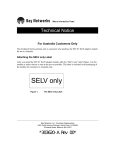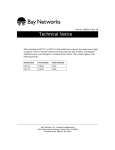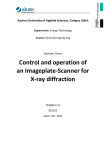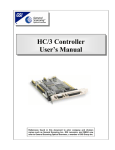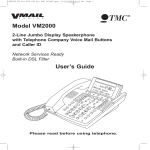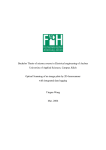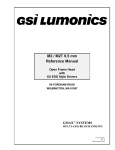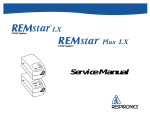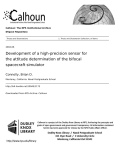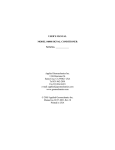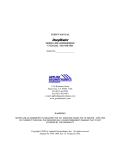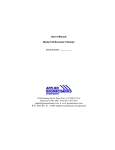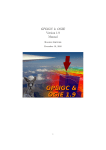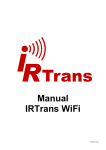Download - Cambridge Technology
Transcript
References found in this document to prior company and division names such as General Scanning Inc., GSI Lumonics, and GMAX now refer to General Scanning Optical Scanners, a member of GSI Group Inc. © March 2007, GSI Group Inc. GSI Group and General Scanning are registered trademarks. The information contained in this document is the sole property of General Scanning. The disclosure of this information does not constitute the release of any proprietary rights therein. Permission to reproduce this information or the products disclosed herein must be obtained in writing from General Scanning. www.gs-scanners.com Contact Information Americas Europe Asia 39 Manning Road Einsteinstrasse 2 Technoport Kamata, 16-1 Billerica, MA 01821 D-85716 Unterschleissheim Minami-Kamata 2-Chome, U.S.A. Germany Ohta-Ku Tokyo 144-0035, Japan TEL: +1 (978) 439-5511 TEL: +49 (89) 31707-0 TEL: +81 (3) 5425-7733 [Sales] FAX: +1 (978) 663-0131 E-mail: [email protected] Toll Free: +1 (800) 342-3757 FAX: +49 (89) 31707-250 E-mail: [email protected] +81 (3) 5714-0557 [Service] FAX: +81 (3) 5425-7738 [Sales] +81 (3) 5714-0566 [Service] E-mail: [email protected] www.gs-scanners.com VM2000 User Manual Component Products Group 39 Manning Road Billerica, Massachusetts 01821 GSIL P/N: 7OM-022 Rev D GSI Lumonics 2001 VM2000 User Manual TABLE OF CONTENTS 1 PRELIMINARY INFORMATION.................................................................................................. 1 1.1 1.2 1.3 WARRANTY ................................................................................................................................... 1 ESD WARNING ............................................................................................................................. 2 CUSTOMER SUPPORT ..................................................................................................................... 2 2 INTRODUCTION.............................................................................................................................. 3 3 SPECIFICATIONS............................................................................................................................ 4 4 MIRRORS AND LOADS .................................................................................................................. 7 5 MOUNTING SCANNERS ................................................................................................................ 8 5.1 5.2 5.3 6 MECHANICAL MOUNTING ............................................................................................................. 8 ELECTRICAL ISOLATION ................................................................................................................ 8 THERMAL CONSIDERATIONS ......................................................................................................... 9 LIFETIME........................................................................................................................................ 10 Component Products Group 39 Manning Road, Billerica, Massachusetts 01821 USA Tel: 978-439-5511 Fax: 978-663-0044 www.gsilumonics.com/opticalscanning/ Part #: 7OM - 022 Page i VM2000 User Manual 1 PRELIMINARY INFORMATION 1.1 Warranty The Customer shall examine each shipment within 10 days of receipt and inform of any shortage or damage within that period. If no discrepancies are reported, GSIL shall assume the shipment was delivered complete and defect free. GSIL warrantees products against defects up to 1 year from manufacture date, barring unauthorized modifications or misuse. Repaired product is warranted 90 days after the repair is made, or one year after manufacture date - whichever is longer. Contact Customer Service to obtain a Return Materials Authorization number before returning any product for repair. All orders are subject to the GSIL Terms and Conditions and Limited Warranty. Visit www.gsilumonics.com/opticalscanning/ for the latest version of these documents and other useful information. IMPORTANT: Line Scan Engines are normally tuned, serialized and warranted as a matched set for optimized performance. Mismatched components negatively affect performance and void the warranty. A matched set typically consists of galvanometer motor, mirror load, electronic driver board and interface cable. Be sure to follow proper Electrostatic Discharge (ESD) precautions when handling line scan engines to prevent driver board electronic failures. Thank you for doing business with GSI Lumonics! Component Products Group 39 Manning Road, Billerica, Massachusetts 01821 USA Tel: 978-439-5511 Fax: 978-663-0044 www.gsilumonics.com/opticalscanning/ Part #: 7OM - 022 Page 1 VM2000 User Manual 1.2 ESD Warning The OEM electronics that GSI Lumonics manufactures - including galvanometers and servo controllers - are sensitive to electrostatic discharge (ESD). Improper handling could therefore damage these electronics. GSI Lumonics has implemented procedures and precautions for handling these devices and we encourage our customers to do the same. Upon receiving your components, you should note that it is packaged in an ESDprotected container with the appropriate ESD warning labels. The equipment should remain sealed until the user is located at a proper static control station. Note: Any equipment returned to the factory must be shipped in anti-static packaging. A proper static control station should include: 1. A soft grounded conductive tabletop or grounded conductive mat on the tabletop. 2. A grounded wrist strap with the appropriate (1 Meg) series resistor connected to the tabletop mat and ground. 3. An adequate earth ground connection such as a water pipe or AC ground. 4. Conductive bags, trays, totes, racks or other containers used for storage. 5. Properly grounded power tools. 6. Personnel handling ESD items should wear ESD protective garments and ground straps. 1.3 Customer Support GSI Lumonics has support services to address your questions or concerns with either the product or manual you are using. Before calling for assistance, be sure to refer to any appropriate sections in the manual that may answer your questions. Call GSI Lumonics’ Customer Service Department Monday through Friday between 8 A.M. and 5 P.M. local time (GMT –05:00 Eastern Time (US & Canada)). The customer service personnel will be able to give you direct assistance and answers to your questions. North America CONTACT US! Europe 39 Manning Rd. Billerica, MA 01821 U.S.A. TEL: (978) 439-5511 FAX: (978) 663-0044 Eisstenstrasse 2 D-85716 Unterschleissheim Germany TEL: (089) 31707 0 FAX: (089) 31707 250 [email protected] [email protected] Asia Technoport Kamata, 16-1 Minami-Kamata 2-Chome Ohta-Ku Tokyo 144-0035 Japan TEL: (81) 3 5714 0380 FAX: (81) 3 5714 0335 [email protected] Website: http://www.gsilumonics.com/opticalscanning/ Component Products Group 39 Manning Road, Billerica, Massachusetts 01821 USA Tel: 978-439-5511 Fax: 978-663-0044 www.gsilumonics.com/opticalscanning/ Part #: 7OM - 022 Page 2 VM2000 User Manual 2 INTRODUCTION The VM2000 manual provides the user with suggestions on proper operation and handling techniques to insure optimum performance and longevity. Highest performance is achieved when the VM2000 is mated with GSI Lumonics newly designed mirror assemblies (patent pending) and optimized Mini-SAX controller. GSI Lumonics refers to a mirror, galvo, and servo set as a line scan engine. The VM2000 has various standard product variations and options to satisfy customer needs: Cable length: 12 inches, 1 meter, and 2 meter Output shaft: Optimized for either 9.5 mm or 15 mm mirrors Thermal control: The VM2000 is offered with and without thermal control. reduces the gain and offset drift by a factor of 5. The thermal control Fanned heat sink: The optional fanned heat sink allows the scanner to be operated in high duty cycle applications. Servo controller: The Mini-SAX driver designed by GSI Lumonics is the recommended servo for the VM2000. The Mini Sax is a wide bandwidth servo that contributes to the very fast dynamic response of the VM2000. Component Products Group 39 Manning Road, Billerica, Massachusetts 01821 USA Tel: 978-439-5511 Fax: 978-663-0044 www.gsilumonics.com/opticalscanning/ Part #: 7OM - 022 Page 3 VM2000 User Manual 3 SPECIFICATIONS Parameter Max Scan Angle Non-Linearity (max) Offset Drift (max) Gain Drift (max) Operating Temperature Optimal Mirror Size Bandwidth (typical) Small Step Time Full Step Size Notes: Units degrees optical % over ±20° optical µRadians / °C PPM / °C °C mm, clear aperture Hz µs ms VM2000 ± 25° .08 30 100 0 - 50 9 – 15 >2500 <300 <1.5 1. Thermal drift specification does not include contribution from servo. 2. The VM2000 is available with optional temperature control that reduces thermal drift by roughly a factor of 5, depending on scanner mount design. Component Products Group 39 Manning Road, Billerica, Massachusetts 01821 USA Tel: 978-439-5511 Fax: 978-663-0044 www.gsilumonics.com/opticalscanning/ Part #: 7OM - 022 Page 4 VM2000 User Manual VM2000 Outline Component Products Group 39 Manning Road, Billerica, Massachusetts 01821 USA Tel: 978-439-5511 Fax: 978-663-0044 www.gsilumonics.com/opticalscanning/ Part #: 7OM - 022 Page 5 VM2000 User Manual VM2000 Outline with Fan Cooling Assembly Component Products Group 39 Manning Road, Billerica, Massachusetts 01821 USA Tel: 978-439-5511 Fax: 978-663-0044 www.gsilumonics.com/opticalscanning/ Part #: 7OM - 022 Page 6 VM2000 User Manual 4 MIRRORS AND LOADS Mirror assembly design is not trivial. A common oversight is to disregard the adverse effect that an improperly balanced mirror has on the galvo’s performance and lifetime. An unbalanced mirror or load can shorten the usable life span of the galvo as it causes transverse excitation of the mirror rotor assembly, leading to premature bearing failure. For best results, we recommend using standard GSI Lumonics mirrors when possible. Custom coatings are available for OEM applications. In the event that standard GSI Lumonics mirrors do not meet your application’s requirement, here are some guidelines follow. The mirror mass and inertia should be minimized and the mirror should be mounted as close as possible to the front bearing of the scanner. All moments of inertia with respect to the axis of rotation should be balanced in order to minimize wobble induced during angular acceleration. The mirror/load should be mounted symmetrically along both axes to prevent imbalance and wobble. Care must be exercised in the bonding process to prevent distortion. Component Products Group 39 Manning Road, Billerica, Massachusetts 01821 USA Tel: 978-439-5511 Fax: 978-663-0044 www.gsilumonics.com/opticalscanning/ Part #: 7OM - 022 Page 7 VM2000 User Manual 5 MOUNTING SCANNERS 5.1 Mechanical Mounting Notice: Scanners should be clamped into a rigid mount. Failure to do so can cause an increase in jitter and wobble. Since the galvo is shielded using the MiniSAX ground, the MiniSAX must be electrically isolated from the mount to avoid noise caused by ground loops. Figure 3: Mounting surfaces of VM2000 Scanner Rigidity of the mounting surface is important in minimizing scanner vibrations and unwanted oscillations or beam movement. Rigidity becomes even more critical when operating larger scanners with high inertial loads. Sources of structural vibration should be investigated so that they do not include significant relative displacement between the scanner and the target. Regardless of the method chosen, the previous sections on heat sinking and electrical isolation should be reviewed. 5.2 Electrical Isolation Line scan engines should be grounded at one point only, preferably at the servo. This means that the scanners should be electrically isolated from each other as well as any other ground path. Hard anodizing or other insulators should be used to provide electrical isolation between scanner and chassis ground. Component Products Group 39 Manning Road, Billerica, Massachusetts 01821 USA Tel: 978-439-5511 Fax: 978-663-0044 www.gsilumonics.com/opticalscanning/ Part #: 7OM - 022 Page 8 VM2000 User Manual 5.3 Thermal Considerations In most vector applications, power dissipation in the scanner is minimal, and therefore the scanner requires little heat sinking. In raster or other high duty cycle applications, maximum heat sinking is desired to maximize the scan frequency and prevent damage to the scanner caused by overheating. When mounting a VM2000 in your system, the thermal relationship between the scanner and its environment should be considered. Caution: Insufficient heat sinking can cause irreparable damage to the scanner. The scanner outside case temperature should never rise above 70° C. To maximize heat flow from the motor case to the heat sink, the surface area should be made as large as possible. Surface finishes should not exceed 64 micro inches. Thermal compound is recommended between the scanner and heat sink, as its thermal impedance is 20 times lower than air. Both passive and fan cooled heat sinks are available from the factory for use in high duty cycle applications. The set point for temperature regulated scanners must be above the highest expected ambient temperature but not above 50 C. For maximum stability, temperature controlled scanners may require thermal isolation from the scanner mount so that heat sinking by the mount does not interfere with temperature regulation. For a more detailed discussion, see the Mini-Sax User’s manual. Component Products Group 39 Manning Road, Billerica, Massachusetts 01821 USA Tel: 978-439-5511 Fax: 978-663-0044 www.gsilumonics.com/opticalscanning/ Part #: 7OM - 022 Page 9 VM2000 User Manual 6 LIFETIME Scanner lifetime will vary depending on many conditions, and is limited in most cases by bearing wear. Environment, command waveform, load inertia, and required resolution among other things will all play a role in dictating the number of usable cycles. Although difficult to predict, experience has provided us with some basic guidelines that can help the user maximize scanner lifetime. Maximum lifetime of the VM2000 will be achieved if: a. The scanner is operated such that it makes random moves over the full field. Commanding repetitive, small angle rotations of any ball bearing device will likely lower the usable lifetime because bearing lubrication is not adequately distributed. b. Mirror/load inertia and mass are minimized. c. Large signal commands are structured to limit acceleration and cross-axis wobble. d. Storage and operation are in a low humidity, dust free environment. The output shaft should not be cleaned with solvents that could flow into the bearings and remove lubrication. Component Products Group 39 Manning Road, Billerica, Massachusetts 01821 USA Tel: 978-439-5511 Fax: 978-663-0044 www.gsilumonics.com/opticalscanning/ Part #: 7OM - 022 Page 10













